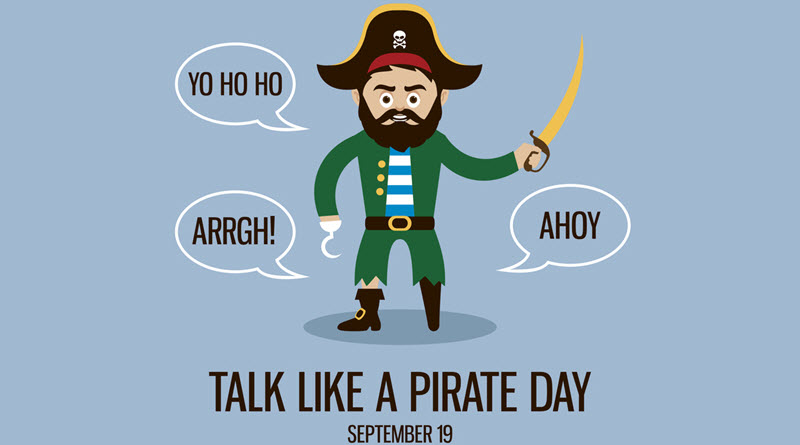| By Jennifer Stock |
On occasion there may be someone you have to execute
But when you’re a professional pirate
You don’t have to wear a suit
— “A Professional Pirate,” Muppets Treasure Island (1996)
Saturday, September 19 is International Talk Like a Pirate Day. This unofficial holiday was the brainchild of John Baur and Mark Summers, two friends who came up with the idea in 1995 during a game of racquetball, when they started speaking to each other in pirate slang. In 2002, Baur reached out to syndicated columnist Dave Barry, who agreed to write a column about the holiday. Suddenly, a holiday that had been celebrated by just two people was embraced by the world.
In honor of Talk Like a Pirate Day, here are some fun pirate facts:
Failed Pirates
The pirate life had undeniable appeal, offering freedom, adventure, and the opportunity to make a fortune in stolen treasure. But not all pirates were successful. Here are some notable examples:
Stede Bonnet (1688–1718)
Stede Bonnet was born an English gentleman. He had no knowledge of seafaring or piracy, which was evident from the start. Most pirates capture a ship and refit it for raiding, but Bonnet simply bought one. He also purchased supplies, rather than stealing them. Due to his lack of knowledge, he was often taken advantage of by his crew. For example, most pirates sign on with the understanding that they will earn a share of the booty, but Bonnet’s crewmen demanded regular wages. Bonnet fell in with English pirate Blackbeard (1680–1718), who essentially took control of Bonnet’s ship. Bonnet tried later to give up piracy, but a lack of money forced him to resume raiding, and he was eventually captured and executed.
William Dampier (1651–1715)
William Dampier wanted to make his fortune at raiding and joined a group of buccaneers. But he always seemed to have bad luck. For example, as the buccaneers launched an attack on the Mexican coast, they discovered that the residents had fled with all their valuables, leaving only a large number of tame parrots. Dampier had more success as an author. During his travels, he took notes about the animals, plants, and Indigenous peoples he encountered. The books he wrote later were admired by naturalists, navigators, and the English public. His account of rescuing a sailor who had been abandoned on a remote island and learned to survive was the inspiration for Daniel Defoe’s novel Robinson Crusoe.
Women Pirates
Although most pirates were male, there are some intrepid women who took on the profession.
Anne Bonny (1700–1720) and Mary Read (1692–1720)
Perhaps the most famous female pirates, Anne Bonny and Mary Read disguised themselves as men and served on the crew of John “Calico Jack” Rackham (1682–1720). Bonny met Rackham in the Bahamas, and the two began a romantic relationship. When her husband refused to grant her a divorce, Bonny sailed off with Rackham. Read joined the crew later, and the two women became friends. When Rackham’s crew was captured by authorities and found guilty at trial, Bonny and Read escaped execution when it was revealed that both women were pregnant.
Ching Shih (Cheng I Sao, ca. 1775–1844)
One of the most successful pirates in history was a woman. Ching Shih was a Chinese prostitute who married a successful pirate leader. Shih became her husband’s partner and, after his death, took command of a vast pirate fleet. She maintained discipline with a strict pirate code.
Did You Know?
- Julius Caesar (100 BCE–44 BCE) was once kidnapped by pirates. The young future emperor was captured by Cilician pirates. These were the most feared pirates in the Mediterranean, but Caesar wasn’t intimidated. When the pirates set his ransom, he informed them that they didn’t know who they were dealing with and promised them more than double the original amount. Once the pirates were paid and Caesar was released, he immediately hired a small fleet and returned to capture (and later execute) the pirates.
- Despite the popular images of pirates burying their treasure, the only pirate known to have actually done so is William Kidd (ca. 1645–1701).
- The youngest pirate in historical record was 11-year-old John King. The boy had been on a voyage with his mother when “Black Sam” Bellamy (ca. 1689–1717) captured their ship. King was so fascinated by the pirates that he begged Bellamy to let him join the crew.
For More Information
Baur and Summers have compiled sources for pirate terms, pirate name generators, and more, on their website.
For general information about pirates, check out the “Pirates and Piracy” portal page at Gale In Context: World History. Additional resources are available from Gale In Context: High School and Gale In Context: Middle School.
To learn more about famous pirates like Blackbeard and William Kidd, go to Gale In Context: Biography.
Gale Literature Resource Center is a great resource on classic literary works featuring pirates, including Peter Pan by J. M. Barrie and Treasure Island by Robert Louis Stevenson.
Meet the Author
Jennifer Stock is a senior content developer at Gale, a Cengage Company, where she has worked on a variety of projects, including eBooks and electronic databases, for K‒12 and academic audiences.

